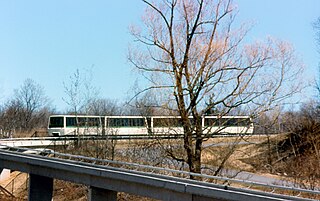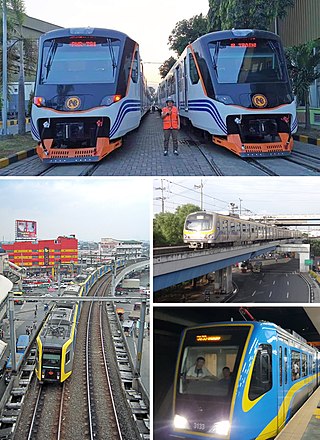
Personal rapid transit (PRT), also referred to as podcars or guided/railed taxis, is a public transport mode featuring a network of specially built guideways on which ride small automated vehicles that carry few passengers per vehicle. PRT is a type of automated guideway transit (AGT), a class of system which also includes larger vehicles all the way to small subway systems. In terms of routing, it tends towards personal public transport systems.

A people mover or automated people mover (APM) is a type of small scale automated guideway transit system. The term is generally used only to describe systems serving relatively small areas such as airports, downtown districts or theme parks.

Kōbe New Transit is the third-sector semipublic company that runs Port Island Line and Rokkō Island Line automated guideway transit (AGT) systems in Kobe, Japan. When opened in 1981, the Port Liner was the world's first fully automated transport system.

An automated guideway transit (AGT) or automated fixed-guideway transit or automatic guideway transit system is a type of fixed guideway transit infrastructure with a riding or suspension track that supports and physically guides one or more driverless vehicles along its length. The vehicles are often rubber tired or steel wheeled, but other traction systems including air cushion, suspended monorail and maglev have been implemented. The guideway provides both physical support, like a road, as well as the guidance. An automated line can be cheaper to run than a conventional line, due to the shorter trains and stations.

An elevated railway or elevated train is a railway with the tracks above street level on a viaduct or other elevated structure. The railway may be broad-gauge, standard-gauge or narrow-gauge railway, light rail, monorail, or a suspension railway. Elevated railways are normally found in urban areas where there would otherwise be multiple level crossings. Usually, the tracks of elevated railways that run on steel viaducts can be seen from street level.

The Toronto Zoo Domain Ride was an automated guideway transit (AGT) service used to carry visitors between sections, or "domains", of the Toronto Zoo. Though technologically closer to a simple rubber-tired metro, it was almost universally referred to as a "monorail".

Rail transportation in the Philippines is currently used mostly to transport passengers within Metro Manila and provinces of Laguna and Quezon, as well as a commuter service in the Bicol Region. Freight transport services once operated in the country, but these services were halted. However, there are plans to restore old freight services and build new lines. From a peak of 1,100 kilometers (680 mi), the country currently has a railway footprint of 533.14 kilometers (331.28 mi), of which only 129.85 kilometers (80.69 mi) are operational as of 2024, including all the urban rail lines. World War II, natural calamities, underspending, and neglect have all contributed to the decline of the Philippine railway network. In the 2019 Global Competitiveness Report, the Philippines has the lowest efficiency score among other Asian countries in terms of efficiency of train services, receiving a score of 2.4, and ranking 86th out of 101 countries globally. The government is currently expanding the railway network up to 1,900 kilometers (1,200 mi) by 2022 through numerous projects.

Daegu Metro is a metro system that serves primarily the South Korean city of Daegu, operated by Daegu Transportation Corporation from 5:30AM to 0:00AM with the interval from 5 to 8 minutes between each car's arrival. With the fastest track speed at 80 km/h (50 mph), it takes 55 minutes for Line 1 and Line 2, and 48 minutes for Line 3 to reach the terminus station. As of 2015, the number of average daily passengers is 186,992 people for Line 1, 177,984 people for Line 2, and 69,127 people for Line 3.

The Stansted Airport Track Transit System (TTS) is a fully automated people mover system which operates within London Stansted Airport in the United Kingdom.
The Computer-controlled Vehicle System, almost universally referred to as CVS, was a personal rapid transit (PRT) system developed by a Japanese industrial consortium during the 1970s. Like most PRT systems under design at the same time, CVS was based around a small four-person electric vehicle similar to a small minivan that could be requested on demand and drive directly to the user's destination. Unlike other PRT systems, however, CVS also offered cargo vehicles, included "dual-use" designs that could be manually driven off the PRT network, and included the ability to stop at intersections in a conventional road-like network.
Krauss-Maffei's Transurban was a 12-passenger automated guideway transit (AGT) mass transit system based on a maglev guideway. Development started in 1970 as one of the many AGT and PRT projects that followed in the wake of the HUD reports of 1968. Its selection as the basis of the GO-Urban system in Toronto in 1973 made it well known in the industry; it would have been the basis of the first large-area AGT mass transit network in the world. Technical problems cropped up during the construction of the test track, and the sudden removal of funding by the West German government led to the project's cancellation in late 1974. The Ontario government completed development and installation of a non-maglev version, today known as the Bombardier Advanced Rapid Transit.

The Dashaveyor was an automated guideway transit (AGT) system developed during the 1960s and '70s.

The University of the Philippines Diliman AGT was an automated guideway transit (AGT) system constructed for technology demonstration within the campus of the University of the Philippines (UP) in Diliman, Quezon City in the Philippines. It served as a test track for the first mass transit system to be built and developed in the country by local engineers.
Minitram was an automated guideway transit system studied by the Transport and Road Research Laboratory (TRRL), part of the UK Department of the Environment's Ministry of Transport. The system was based on small, completely automated tram-like vehicles of about 25 passengers that could be connected together into three-car trains to increase capacity. Proposed designs were submitted by Hawker Siddeley Dynamics (HSD) and EASAMS. HSD's system used rubber wheels and EASAMS' steerable steel ones, but the projects were otherwise similar and notably shared a linear motor for propulsion and most braking. A series of failed sales efforts in the UK and to the GO-Urban system in Toronto, combined with decreased government spending in the 1970s, led to the concept being abandoned.

The Oakland Airport Connector is an automated guideway transit (AGT) system operated by Bay Area Rapid Transit (BART) between BART's Coliseum station and Oakland International Airport station. The line is colored on BART maps as the Beige Line. The system is integrated into BART's fare system. The line opened for revenue service on November 22, 2014, replacing the AirBART shuttle bus service that had operated since July 1, 1977. Currently operating between two terminal stations, the system includes provisions for an intermediate third station that may be built at a later date.
The Metro Rail Transit Line 4 (MRT-4) is an upcoming rapid transit line serving the Greater Manila Area of the Philippines. The 12.7 km (7.9 mi), 10-station elevated railway will connect Ortigas Center in Metro Manila and the suburban municipality of Taytay, Rizal. It will traverse along Ortigas Avenue and Manila East Road, starting at the former's junction with EDSA in Quezon City to the west until it terminates near the New Taytay Public Market to the east.

The Tampa International Airport People Movers are a set of automated people mover systems operating within Tampa International Airport. The primary set of people movers are automated guideway transit (AGT) systems that connect the airport's main terminal to four satellite airside concourses. Opened in 1971, the landside/airside shuttles were the first people movers used to transport passengers within an airport terminal and it is today Bombardier Transportation's longest running people mover system. A fifth people mover line known as SkyConnect, which began operating in 2018, connects the main terminal with the airport's economy parking garage and rental car center. In addition, a monorail once connected the main terminal and the long-term parking garage from 1991 until its closure in 2020.
The Philippine government has commenced a project to develop a locally designed and manufactured Automated Guideway Transit System (AGTS) through its Department of Science and Technology (DOST). Two prototype lines has been set up by the DOST, one within the University of the Philippines Diliman campus and another in Bicutan in Taguig.
The Cebu Monorail Transit System, simply known as the Cebu Monorail, is a proposed monorail rapid transit system to be built in Metro Cebu, Philippines. Originally proposed by the Japanese in 2015 as the Cebu MRT System, it was revised to a light rail line in the late 2010s, dubbed the Cebu Light Rail Transit System or Cebu LRT. It was then again revised to its present form in late 2019.











